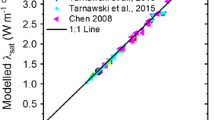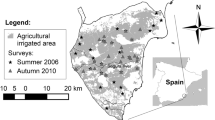Abstract
There are various factors that affect soil electrical conductivity (EC) measurements, including soil texture, soil water content, cation exchange capacity (CEC) and others. Temperature is an important environmental variable, and different models can be used to correct for its effect on EC measurements and standardize the measurements to 25°C. It is relevant to analyze these models and to determine whether they are consistent with each other. Some models were wrongly cited. We found that the exponential model of Sheets and Hendrickx as corrected by Corwin and Lesch in 2005 performs the best. The ratio model also performs well between 3°C and 47°C.







Similar content being viewed by others
References
Auerswald, K., Simon, S., & Stanjek, H. (2001). Influence of soil properties on electrical conductivity under humid water regimes. Soil Science, 166, 382–390.
Barry, J. A., Douglas Groom, M., Reza, E., & Jeffrey, J. D. (2008). Resistivity methods. In J. A. Barry, J. D. Jeffrey, & M. R. Ehsani (Eds.), Handbook of agricultural geophysics (pp. 86–91). Boca Raton, FL: CRC Press.
Besson, A., Cousin, I., Dorigny, A., Dabas, M., & King, D. (2008). The temperature correction for the electrical resistivity measurements in undisturbed soil samples: Analysis of the existing conversion models and proposal of a new model. Soil Science, 173, 707–720.
Brevik, E. C., Fenton, T. E., & Horton, R. (2004). Effect of daily soil temperature fluctuations on soil electrical conductivity as measured with the Geonics EM-38. Precision Agriculture, 5, 145–152.
Campbell, R. B., Bower, C. A., & Richards, L. A. (1948). Change of electrical conductivity with temperature and the relation of osmotic pressure to electrical conductivity and ion concentration for soil extracts. Soil Science Society of America Proceedings, 13, 66–69.
Corwin, D. L., & Lesch, S. M. (2005). Apparent soil electrical conductivity measurements in agriculture. Computers and Electronics in Agriculture, 46, 11–43.
Dalliger, T. E. (2006). Geometric and temperature effects on time domain reflectometry measurements in soils. Masters Thesis, Purdue University, West Lafayette, IN.
Drnevich,V. P., Zambrano, C. E., Jung, S., & Clarke, J. P. (2008). Electrical conductivity of soils and soil properties. In A. Alshawabkeh, K. R. Reddy, & M. V. Khire (Eds.), GeoCongress 2008: Characterization, monitoring, and modeling of GeoSystems (pp. 317–323). Geotechnical special publication No. 179. New Orleans, LA: The American Society of Civil Engineers.
Durlesser, H. (1999). Bestimmung der Variation bodenphysikalischer Parameter in Raum und Zeit mit elektromagnetischen Induktionsverfahren (Determination of the spatial and temporal variability of physical soil parameters using electromagnetic induction). Stuttgart: Shaker Verlag (in German).
Eijkelkamp Agrisearch Equipment. (2003). Operating instructions, EC-probe set for soil conductivity measurements. The Netherlands.
Franson, M. A. H. (1985). Standard methods for the examination of water and wastewater (16th ed.). Washington, DC: American Public Health Association.
Friedman, S. P. (2005). Soil properties influencing apparent electrical conductivity: A review. Computers and Electronics in Agriculture, 46, 45–70.
Hayashi, M. (2004). Temperature-electrical conductivity relation of water for environmental monitoring and geophysical data inversion. Environmental Monitoring and Assessment, 96, 119–128.
Heimovaara, T. J., Focke, A. G., Boute, W., & Verstraten, J. M. (1995). Assessing temporal variations in soil water composition with time domain reflectometry. Soil Science Society of America Journal, 59, 689–698.
Huth, N. I., & Poulton, P. I. (2007). An electromagnetic induction method for monitoring variation in soil moisture in agroforestry systems. Australian Journal of Soil Research, 45, 63–72.
Keller, G. V., & Frischknecht, F. C. (1966). Electrical methods in geophysical prospecting (pp. 30–33). Oxford, UK: Pergamon Press.
Lück, E., Rühlmann, J., & Spangenberg, U. (2005). Physical background of soil EC mapping: Laboratory, theoretical and field studies. In J. V. Stafford (Ed.), Precision agriculture’05 (pp. 417–424). The Netherlands: Wageningen Academic Publishers.
Persson, M., & Berndtsson, R. (1998). Texture and electrical conductivity effects on temperature dependency in time domain reflectometry. Soil Science Society of America Journal, 62, 887–893.
Rhoades, J. D., Chanduvi, F., & Lesch, S. (1999). Soil salinity assessment: Methods and interpretation of electrical conductivity measurements (pp. 1–150). FAO Irrigation and Drainage Paper No. 57. Rome, Italy: Food and Agriculture Organization of the United Nations.
Robinson, D. A., Lebron, I., Lesch, S. M., & Shouse, P. (2004). Minimizing drift in electrical conductivity measurements in high temperature environments using the EM-38. Soil Science Society of America Journal, 68, 339–345.
Scollar, I., Tabbagh, A., Hesse, A., & Herzog, I. (1990). Archaeological prospecting and remote sensing. New York: The Press Syndicate of the University of Cambridge.
Sheets, K. R., & Hendrickx, J. M. H. (1995). Non-invasive soil water content measurement using electromagnetic induction. Water Resource Research, 31, 2401–2409.
Slavich, P. G., & Petterson, G. H. (1990). Estimating average rootzone salinity from electromagnetic induction (EM-38) measurements. Australian Journal of Soil Research, 28, 453–463.
Sorensen, J. A., & Glass, G. E. (1987). Ion and temperature dependence of electrical conductance for natural waters. Analytical Chemistry, 59, 1594–1597.
Stogryn, A. (1971). Equations for calculating the dielectric constant of saline water. IEEE Transactions of Microwave Theory and Techniques, 19, 733–736.
Sudduth, K. A., Drummond, S. T., & Kitchen, N. R. (2001). Accuracy issues in electromagnetic induction sensing of soil electrical conductivity for precision agriculture. Computers and Electronics in Agriculture, 31, 239–264.
U.S. Salinity Laboratory Staff. (1954). Diagnosis and improvement of saline and alkali soils. In L. A. Richards (Ed.), USDA agriculture handbook no. 60 (pp. 90). Washington, D.C.: U.S. Government Printing Office.
Ulaby, F. T., Moore, R. K., & Fung, A. K. (1986). Microwave remote sensing: Active and passive, vol. III, from theory to applications (pp. 2022–2025). Dedham, MA: Artech House.
Wells, C. B. (1978). Electrolytic conductivity of soil solutions and wares: conversions from field to standard temperatures. Division of Soils Technical Paper No. 37, 1–17. Commonwealth Scientific and Industrial Research Organization, Australia.
Wely, P. K. (1964). On the change in electrical conductance of sea water with temperature. Limnology Oceanography, 9, 75–78.
Wooster, W. S., Lee, A. J., & Dietrich, G. (1969). Redefinition of salinity. Deep-Sea Research, 16, 321–322.
Wraith, J. M., & Or, D. (1999). Temperature effects on soil bulk dielectric permittivity measured by time domain reflectometry: Experimental evidence and hypothesis development. Water Resource Research, 35, 361–369.
Acknowledgements
We thank the support provided by China Scholarship Council for a visiting scholarship at the Australian Centre for Precision Agriculture, Faculty of Agriculture, Food and Natural Resources, The University of Sydney. Thanks are also extended to the Australian Research Council, providing funds for a Discovery Project on High Resolution Digital Soil Mapping. The authors also thank the reviewers for their insight and comprehensive comments on the original manuscript.
Author information
Authors and Affiliations
Corresponding author
Rights and permissions
About this article
Cite this article
Ma, R., McBratney, A., Whelan, B. et al. Comparing temperature correction models for soil electrical conductivity measurement. Precision Agric 12, 55–66 (2011). https://doi.org/10.1007/s11119-009-9156-7
Published:
Issue Date:
DOI: https://doi.org/10.1007/s11119-009-9156-7




